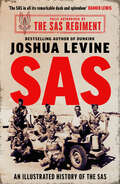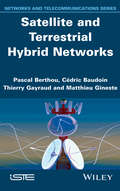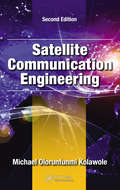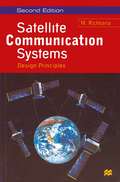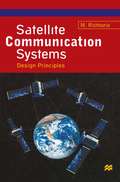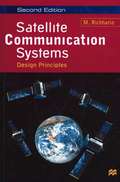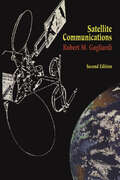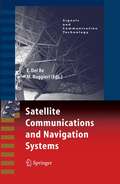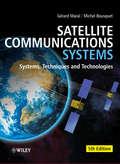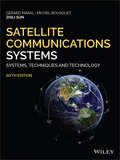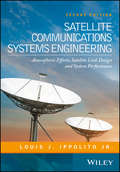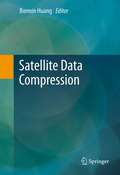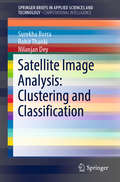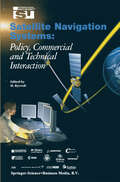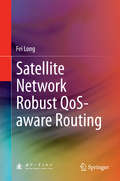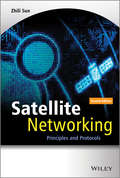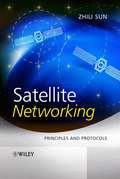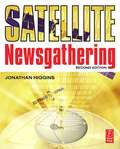- Table View
- List View
SAS: The Illustrated History Of The Sas
by Joshua LevineThe authorised illustrated history of the SAS by the number one bestselling author of Dunkirk, Joshua Levine. With never-before-seen photographs and unheard stories, this is the SAS’s wartime history in vivid and astonishing detail.
Satellite and Terrestrial Hybrid Networks
by Pascal Berthou Cédric Baudoin Thierry Gayraud Matthieu GinesteThis book offers the reader the keys for a successful understanding, integration and usage of satellite systems in addition to next generation terrestrial networks. The DVB-S2/RCS system is used to illustrate the integration challenges. The presentation uses a system approach, i.e. it tackles the terrestrial and satellite telecommunication systems’ complexity with a high level approach, focusing on the systems’ components and on their interactions. Several scenarios present the different paths that can be followed for the integration of satellite systems in terrestrial networks. Quality of Service management techniques in terrestrial and satellite systems and the solutions to help them to interoperate are provided. Inter-system mobility solutions and performance problems are then addressed. The solutions proposed in this book have been developed within the framework of European and French funded research projects and tested with simulated or real testbeds.
Satellite and Terrestrial Hybrid Networks
by Pascal Berthou Cédric Baudoin Thierry Gayraud Matthieu GinesteThis book offers the reader the keys for a successful understanding, integration and usage of satellite systems in addition to next generation terrestrial networks. The DVB-S2/RCS system is used to illustrate the integration challenges. The presentation uses a system approach, i.e. it tackles the terrestrial and satellite telecommunication systems’ complexity with a high level approach, focusing on the systems’ components and on their interactions. Several scenarios present the different paths that can be followed for the integration of satellite systems in terrestrial networks. Quality of Service management techniques in terrestrial and satellite systems and the solutions to help them to interoperate are provided. Inter-system mobility solutions and performance problems are then addressed. The solutions proposed in this book have been developed within the framework of European and French funded research projects and tested with simulated or real testbeds.
Satellite Communication Engineering
by Michael Olorunfunmi KolawoleAn undeniably rich and thorough guide to satellite communication engineering, Satellite Communication Engineering, Second Edition presents the fundamentals of information communications systems in a simple and succinct way. This book considers both the engineering aspects of satellite systems as well as the practical issues in the broad field of information transmission. Implementing concepts developed on an intuitive, physical basis and utilizing a combination of applications and performance curves, this book starts off with a progressive foundation in satellite technology, and then moves on to more complex concepts with ease. What’s New in the Second Edition: The second edition covers satellite and Earth station design; global positioning systems; antenna tracking; links and communications systems; error detection and correction; data security; regulations and procedures for system modeling; integration; testing; and reliability and performance evaluation. Provides readers with the systems building blocks of satellite transponders and Earth stations, as well as the systems engineering design procedure Includes the tools needed to calculate basic orbit characteristics such as period, dwell time, coverage area, propagation losses; antenna system features such as size, beamwidth, aperture-frequency product, gain, tracking control; and system requirements such as power, availability, reliability, and performance Presents problem sets and starred sections containing basic mathematical development Details recent developments enabling digital information transmission and delivery via satellite Satellite Communication Engineering, Second Edition serves as a textbook for students and a resource for space agencies and relevant industries.
Satellite Communication Engineering
by Michael Olorunfunmi KolawoleAn undeniably rich and thorough guide to satellite communication engineering, Satellite Communication Engineering, Second Edition presents the fundamentals of information communications systems in a simple and succinct way. This book considers both the engineering aspects of satellite systems as well as the practical issues in the broad field of information transmission. Implementing concepts developed on an intuitive, physical basis and utilizing a combination of applications and performance curves, this book starts off with a progressive foundation in satellite technology, and then moves on to more complex concepts with ease. What’s New in the Second Edition: The second edition covers satellite and Earth station design; global positioning systems; antenna tracking; links and communications systems; error detection and correction; data security; regulations and procedures for system modeling; integration; testing; and reliability and performance evaluation. Provides readers with the systems building blocks of satellite transponders and Earth stations, as well as the systems engineering design procedure Includes the tools needed to calculate basic orbit characteristics such as period, dwell time, coverage area, propagation losses; antenna system features such as size, beamwidth, aperture-frequency product, gain, tracking control; and system requirements such as power, availability, reliability, and performance Presents problem sets and starred sections containing basic mathematical development Details recent developments enabling digital information transmission and delivery via satellite Satellite Communication Engineering, Second Edition serves as a textbook for students and a resource for space agencies and relevant industries.
Satellite Communication Systems: Design Principles
by Madhavendra RichhariaThis state-of-the art guide offers an in-depth treatment of the elements and components that comprise satellite communication systems. The book takes the reader step-by-step through the principles and methods of system design - all in easy-to-understand language avoiding long mathematical derivations.
Satellite Communication Systems (PDF)
by M. RichhariaThis state-of-the art guide offers an in-depth treatment of the elements and components that comprise satellite communication systems. The book takes the reader step-by-step through the principles and methods of system design - all in easy-to-understand language avoiding long mathematical derivations.
Satellite Communications
by Robert M. GagliardiThis second edition of Satellite Communications is a revised, updated, and improved version of the first edition (Van Nostrand, 1984) and has been extended to include many newer topics that are rapidly becoming important in modem and next-generation satellite systems. The first half of the book again covers the basics of satellite links, but has been updated to include additional areas such as Global Positioning and deep space satellites, dual polarization, multiple beaming, advanced satellite electronics, frequency synthesizers, and digital frequency generators. The second half of the book is all new, covering frequency and beam hopping, on-board processing, EHF and optical cross links, and mobile satellites and VSAT systems. All of these latter topics figure to be important aspects of satellite systems and space platforms of the twenty-first century. As in the first edition, the objective of the new edition is to present a unified approach to satellite communications, helping the reader to become familiar with the terminology, models, analysis procedures, and evolving design directions for modem and future satellites. The presentation stresses overall system analysis and block diagram design, as opposed to complicated mathematical or physics descriptions. (Backup mathematics is relegated to the appendices where a reader can digest the detail at his own pace. ) The discussion begins with the simplest satellite systems and builds to the more complex payloads presently being used.
Satellite Communications and Navigation Systems (Signals and Communication Technology)
by Enrico Re Marina RuggieriSatellite Communications and Navigation Systems publishes the proceedings of the 2006 Tyrrhenian International Workshop on Digital Communications. The book focuses on the integration of communication and navigation systems in satellites.
Satellite Communications Systems: Systems, Techniques and Technology
by Gerard Maral Michel BousquetRevisions to 5th Edition by: Zhili Sun, University of Surrey, UK New and updated edition of this authoritative and comprehensive reference to the field of satellite communications engineering Building on the success of previous editions, Satellite Communications Systems, Fifth Edition covers the entire field of satellite communications engineering from orbital mechanics to satellite design and launch, configuration and installation of earth stations, including the implementation of communications links and the set-up of the satellite network. This book provides a comprehensive treatment of satellite communications systems engineering and discusses the technological applications. It demonstrates how system components interact and details the relationship between the system and its environment. The authors discuss the systems aspects such as techniques enabling equipment and system dimensioning and state of the art technology for satellite platforms, payloads and earth stations. New features and updates for the fifth edition include: More information on techniques allowing service provision of multimedia content Extra material on techniques for broadcasting, including recent standards DVB-RCS and DVB-S2 (Digital Video Broadcasting -Return Channel Satellite and -Satellite Version 2) Updates on onboard processing By offering a detailed and practical overview, Satellite Communications Systems continues to be an authoritative text for advanced students, engineers and designers throughout the field of satellite communications and engineering.
Satellite Communications Systems: Systems, Techniques and Technology
by Gerard Maral Michel BousquetRevisions to 5th Edition by: Zhili Sun, University of Surrey, UK New and updated edition of this authoritative and comprehensive reference to the field of satellite communications engineering Building on the success of previous editions, Satellite Communications Systems, Fifth Edition covers the entire field of satellite communications engineering from orbital mechanics to satellite design and launch, configuration and installation of earth stations, including the implementation of communications links and the set-up of the satellite network. This book provides a comprehensive treatment of satellite communications systems engineering and discusses the technological applications. It demonstrates how system components interact and details the relationship between the system and its environment. The authors discuss the systems aspects such as techniques enabling equipment and system dimensioning and state of the art technology for satellite platforms, payloads and earth stations. New features and updates for the fifth edition include: More information on techniques allowing service provision of multimedia content Extra material on techniques for broadcasting, including recent standards DVB-RCS and DVB-S2 (Digital Video Broadcasting -Return Channel Satellite and -Satellite Version 2) Updates on onboard processing By offering a detailed and practical overview, Satellite Communications Systems continues to be an authoritative text for advanced students, engineers and designers throughout the field of satellite communications and engineering.
Satellite Communications Systems: Systems, Techniques and Technology
by Gerard Maral Michel Bousquet Zhili SunThe revised and updated sixth edition of Satellite Communications Systems contains information on the most recent advances related to satellite communications systems, technologies, network architectures and new requirements of services and applications. The authors – noted experts on the topic – cover the state-of-the-art satellite communication systems and technologies and examine the relevant topics concerning communication and network technologies, concepts, techniques and algorithms. New to this edition is information on internetworking with the broadband satellite systems, more intensive coverage of Ka band technologies, GEO high throughput satellite (HTS), LEO constellations and the potential to support the current new broadband Internet services as well as future developments for global information infrastructure. The authors offer details on digital communication systems and broadband networks in order to provide high-level researchers and professional engineers an authoritative reference. The companion website provides slides for instructors to teach and for students to learn. In addition, the book is designed in a user-friendly format.
Satellite Communications Systems: Systems, Techniques and Technology
by Gerard Maral Michel Bousquet Zhili SunThe revised and updated sixth edition of Satellite Communications Systems contains information on the most recent advances related to satellite communications systems, technologies, network architectures and new requirements of services and applications. The authors – noted experts on the topic – cover the state-of-the-art satellite communication systems and technologies and examine the relevant topics concerning communication and network technologies, concepts, techniques and algorithms. New to this edition is information on internetworking with the broadband satellite systems, more intensive coverage of Ka band technologies, GEO high throughput satellite (HTS), LEO constellations and the potential to support the current new broadband Internet services as well as future developments for global information infrastructure. The authors offer details on digital communication systems and broadband networks in order to provide high-level researchers and professional engineers an authoritative reference. The companion website provides slides for instructors to teach and for students to learn. In addition, the book is designed in a user-friendly format.
Satellite Communications Systems Engineering: Atmospheric Effects, Satellite Link Design and System Performance (Wireless Communications And Mobile Computing Ser.)
by Louis J. Ippolito Jr.The first edition of Satellite Communications Systems Engineering (Wiley 2008) was written for those concerned with the design and performance of satellite communications systems employed in fixed point to point, broadcasting, mobile, radio navigation, data relay, computer communications, and related satellite based applications. This welcome Second Edition continues the basic premise and enhances the publication with the latest updated information and new technologies developed since the publication of the first edition. The book is based on graduate level satellite communications course material and has served as the primary text for electrical engineering Masters and Doctoral level courses in satellite communications and related areas. Introductory to advanced engineering level students in electrical, communications and wireless network courses, and electrical engineers, communications engineers, systems engineers, and wireless network engineers looking for a refresher will find this essential text invaluable.
Satellite Communications Systems Engineering: Atmospheric Effects, Satellite Link Design and System Performance
by Louis J. Ippolito Jr.The first edition of Satellite Communications Systems Engineering (Wiley 2008) was written for those concerned with the design and performance of satellite communications systems employed in fixed point to point, broadcasting, mobile, radio navigation, data relay, computer communications, and related satellite based applications. This welcome Second Edition continues the basic premise and enhances the publication with the latest updated information and new technologies developed since the publication of the first edition. The book is based on graduate level satellite communications course material and has served as the primary text for electrical engineering Masters and Doctoral level courses in satellite communications and related areas. Introductory to advanced engineering level students in electrical, communications and wireless network courses, and electrical engineers, communications engineers, systems engineers, and wireless network engineers looking for a refresher will find this essential text invaluable.
Satellite Data Compression: 31 July-1 August, 2005, San Diego, California, Usa (Proceedings Of Spie Ser. #5889)
by Bormin HuangSatellite Data Compression covers recent progress in compression techniques for multispectral, hyperspectral and ultra spectral data. A survey of recent advances in the fields of satellite communications, remote sensing and geographical information systems is included. Satellite Data Compression, contributed by leaders in this field, is the first book available on satellite data compression. It covers onboard compression methodology and hardware developments in several space agencies. Case studies are presented on recent advances in satellite data compression techniques via various prediction-based, lookup-table-based, transform-based, clustering-based, and projection-based approaches. This book provides valuable information on state-of-the-art satellite data compression technologies for professionals and students who are interested in this topic. Satellite Data Compression is designed for a professional audience comprised of computer scientists working in satellite communications, sensor system design, remote sensing, data receiving, airborne imaging and geographical information systems (GIS). Advanced-level students and academic researchers will also benefit from this book.
Satellite Image Analysis: Clustering and Classification (SpringerBriefs in Applied Sciences and Technology)
by Surekha Borra Rohit Thanki Nilanjan DeyThanks to recent advances in sensors, communication and satellite technology, data storage, processing and networking capabilities, satellite image acquisition and mining are now on the rise. In turn, satellite images play a vital role in providing essential geographical information. Highly accurate automatic classification and decision support systems can facilitate the efforts of data analysts, reduce human error, and allow the rapid and rigorous analysis of land use and land cover information. Integrating Machine Learning (ML) technology with the human visual psychometric can help meet geologists’ demands for more efficient and higher-quality classification in real time. This book introduces readers to key concepts, methods and models for satellite image analysis; highlights state-of-the-art classification and clustering techniques; discusses recent developments and remaining challenges; and addresses various applications, making it a valuable asset for engineers, data analysts and researchers in the fields of geographic information systems and remote sensing engineering.
Satellite Navigation Systems: Policy, Commercial and Technical Interaction (Space Studies #8)
by M. RycroftT. Ito, International Space University, Strasbourg Central Campus, 1 Rue Jean Dominique Cassini, Parc d'Innovation, 67400 lllkirch-Graffenstaden, France e-mail: ito@isu. isunet. edu M. J. Rycroft, CAESAR Consultancy, 35 Millington Road, Cambridge CB3 9HW, UK e-mail: Michael. J. Rycroft®ukgateway. net As Symposium Committee Chair for the 2003 International Space University (ISU) Symposium, and Editor of this Proceedings volume, respectively, we write this introduction. The success of previous ISU symposia suggests that the ISU has developed a unique and winning formula for a novel type of symposium. The characteristics of ISU symposia are that they: • Adopt a broad, and interdisciplinary, perspective • Address all aspects of the subject, ranging from policy, business, organisational, and legal issues to technical and scientific topics • Foster a constructive dialogue among very different sectors of the space community, and • Allow ample time for interactive discussions. The present Symposium is no exception. It considers the very timely topic of space-based systems for global positioning and navigation, ranging from the GPS system developed by the US military to the Russian GLONASS system, and on to the future European Galileo system. Other nations are planning regional augmentation systems.
Satellite Network Robust QoS-aware Routing
by Fei LongSatellite Network Robust QoS-aware Routing presents a novel routing strategy for satellite networks. This strategy is useful for the design of multi-layered satellite networks as it can greatly reduce the number of time slots in one system cycle. The traffic prediction and engineering approaches make the system robust so that the traffic spikes can be handled effectively. The multi-QoS optimization routing algorithm can satisfy various potential user requirements. Clear and sufficient illustrations are also presented in the book. As the chapters cover the above topics independently, readers from different research backgrounds in constellation design, multi-QoS routing, and traffic engineering can benefit from the book.Fei Long is a senior engineer at Beijing R&D Center of 54th Research Institute of China Electronics Technology Group Corporation.
Satellite Networking: Principles and Protocols
by Zhili SunThis book provides up to date coverage of the basics of ATM and internet protocols, and characteristics of satellite networks and internetworking between satellite and terrestrial networks Satellite Networking: Principles and Protocols, Second Edition provides up to date information of the original topics in satellite networking and protocols focusing on Internet Protocols (IP) over satellites, broadband over satellites, next generation IP (IPv6) over satellites, new generation of DVB-S/S2 and DVB-RCS next generations and new services and applications. It also includes some analytical techniques for evaluation of end to end IP performance and QoS over satellite, reflecting the recent convergence of telecommunication, Internet, broadcasting and mobile networks. Topics new to this edition: Internetworking with MANET, DVB-S/S2 and DVB-RCS/RCS2 (including TCP/IP over DVB-S/RCS), recent developments in broadband satellite systems, convergence of services and network technologies (including Internet, telecom, mobile, TV, etc.), radio resource management, PEP, I-PEP, SCPS, traffic modelling and engineering with analysis and examples, and future developments of satellite networking. Provides up to date coverage of the basics of ATM and internet protocols, and characteristics of satellite networks and internetworking between satellite and terrestrial networks (e.g. mobile ad hoc networks), including coverage of new services and applications (e.g. Internet, telecom, mobile and TV) Discusses the real-time protocols including RTP, RTCP and SIP for real-time applications such as VoIP and MMC, and explains TCP/IP over satellite and evolution of IPv6 over satellite and beyond
Satellite Networking: Principles and Protocols
by Zhili SunThis book provides up to date coverage of the basics of ATM and internet protocols, and characteristics of satellite networks and internetworking between satellite and terrestrial networks Satellite Networking: Principles and Protocols, Second Edition provides up to date information of the original topics in satellite networking and protocols focusing on Internet Protocols (IP) over satellites, broadband over satellites, next generation IP (IPv6) over satellites, new generation of DVB-S/S2 and DVB-RCS next generations and new services and applications. It also includes some analytical techniques for evaluation of end to end IP performance and QoS over satellite, reflecting the recent convergence of telecommunication, Internet, broadcasting and mobile networks. Topics new to this edition: Internetworking with MANET, DVB-S/S2 and DVB-RCS/RCS2 (including TCP/IP over DVB-S/RCS), recent developments in broadband satellite systems, convergence of services and network technologies (including Internet, telecom, mobile, TV, etc.), radio resource management, PEP, I-PEP, SCPS, traffic modelling and engineering with analysis and examples, and future developments of satellite networking. Provides up to date coverage of the basics of ATM and internet protocols, and characteristics of satellite networks and internetworking between satellite and terrestrial networks (e.g. mobile ad hoc networks), including coverage of new services and applications (e.g. Internet, telecom, mobile and TV) Discusses the real-time protocols including RTP, RTCP and SIP for real-time applications such as VoIP and MMC, and explains TCP/IP over satellite and evolution of IPv6 over satellite and beyond
Satellite Networking: Principles and Protocols
by Zhili SunSatellite networking is an exciting and expanding field that has evolved significantly since the launch of the first telecommunications satellite, from telephone and broadcast to broadband ATM and Internet. With increasing bandwidth and mobility demands on the horizon, satellites have become an integral part of the Global Network Infrastructure (GNI). Satellite Networking: Principles and Protocols provides a balanced coverage of satellite topics from a network point of view, focusing on network aspects, services and applications, quality of service (QoS) and principles and protocols. Introduces the basics of ATM and internet protocols, and characteristics of satellite networks and internetworking between satellite and terrestrial networks Discusses the real-time protocols including RTP, RTCP and SIP for real-time applications such as VoIP and MMC Coverage of new services and applications, internet traffic engineering and MPLS Examines IPv6 over satellite using tunnelling and translation techniques, evolution of earth stations, user terminals and network protocols, and development of satellite networking Includes a Companion Website featuring: Solutions manual, and electronic versions of the figures This text is essential reading for senior undergraduates, postgraduates, and researchers in the fields of satellites, communications and networks. It will also have instant appeal to engineers, managers and operators in these fields.
Satellite Newsgathering
by Jonathan HigginsPraise for the first edition:"It is a wonderful source of information and has the merit of going straight to the subject, being technically precise although very easy to understand. There are numerous pictures, photographs, diagrams, which make the reading a real pleasure." --European Broadcasting Union Technical Review "The complexity of a satellite newsgathering system could be a four-month long college course with a high tuition rate and an enrolment number so large you have to watch your professor on a TV screen. Jonathan Higgins might have saved the independent learner a few attendance point deductions by fitting it into one book." --Satellite Broadband magazineAn ideal introduction for anyone working, or interested, in satellite newsgathering (SNG). The new edition of this popular book builds upon the success of the first--an important and valuable work that is extermely easy to read, comprehensive in its treatment, and detailed where necessary. SNG used to be an immensely complex and expensive affair where broadcasting organizations were at the mercy of an expert who sat in a lonely corner, until needed. Things have changed--everyone in a global news organization needs to know about it now. This is not only because of the high costs of mistakes, but because now even non-technical journalists on the ground have to operate their own equipment. Learn the skills, basics of equipment, cutting edge technology and critical safety issues of satellite newsgathering.
Satellite Newsgathering
by Jonathan HigginsPraise for the first edition:"It is a wonderful source of information and has the merit of going straight to the subject, being technically precise although very easy to understand. There are numerous pictures, photographs, diagrams, which make the reading a real pleasure." --European Broadcasting Union Technical Review "The complexity of a satellite newsgathering system could be a four-month long college course with a high tuition rate and an enrolment number so large you have to watch your professor on a TV screen. Jonathan Higgins might have saved the independent learner a few attendance point deductions by fitting it into one book." --Satellite Broadband magazineAn ideal introduction for anyone working, or interested, in satellite newsgathering (SNG). The new edition of this popular book builds upon the success of the first--an important and valuable work that is extermely easy to read, comprehensive in its treatment, and detailed where necessary. SNG used to be an immensely complex and expensive affair where broadcasting organizations were at the mercy of an expert who sat in a lonely corner, until needed. Things have changed--everyone in a global news organization needs to know about it now. This is not only because of the high costs of mistakes, but because now even non-technical journalists on the ground have to operate their own equipment. Learn the skills, basics of equipment, cutting edge technology and critical safety issues of satellite newsgathering.
